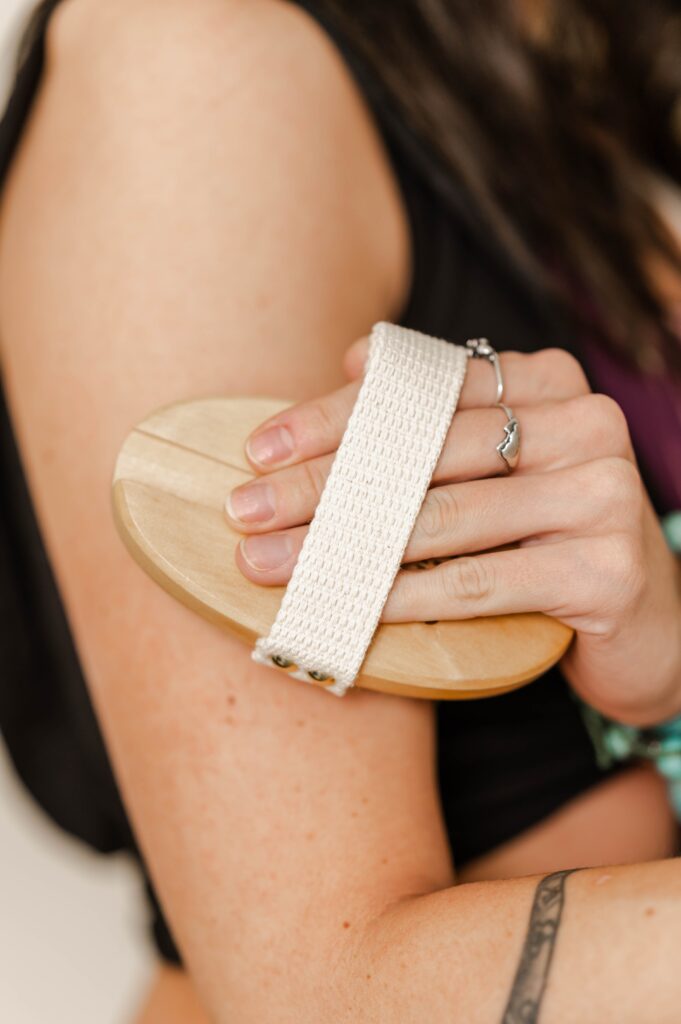
While most of us are quite familiar with brushing our hair and brushing our teeth as part of our daily self-care routines, there’s another lesser-known brush technique with a range of health benefits: dry brushing.
Dry brushing has gained more recent mainstream popularity, but this health and beauty ritual is by no means new to the wellness world. From Ancient Greece to Japan, skin exfoliation has been practiced for centuries across cultures, using materials such as crushed seashells, sand and even corn cobs. In India, Ayurvedic dry massage (called garshana) is traditionally performed using linen gloves or raw silk. But for those of us without raw silk at our disposal (darn!), a natural bristle body brush will do the trick.
what is dry brushing?
So what is this trending “dry brushing” wellness practice? Well… it’s exactly what it sounds like—the process of brushing the skin with a firm bristled brush. Pretty simple, though there’s a little more to it (and we’ll get to that in a moment!).
But first, why bother?
While there’s limited scientific evidence of the health benefits of dry brushing, many swear by this technique and cite numerous positive results. Here are just a few:
health benefits of dry brushing
exfoliation
The natural brush bristles exfoliate skin by removing flaky, dead skin cells. A single dry brush session buffs and softens skin, improving its appearance. Yay, smooth, radiant skin!
circulatory & lymphatic support
A major part of the body’s immune and circulatory systems, the lymphatic system transports lymph (a clear fluid containing white blood cells) throughout the body and helps rid it of toxins and waste. Because many lymph vessels are located directly beneath the skin, dry brushing works similar to massage therapy by stimulating lymph flow and drainage (a natural process sped up by a little help from our brush friend!).
The stiff bristles also clean skin pores, opening detox pathways for the body to release toxins through sweat.
cellulite reduction
In addition to supporting the lymphatic system, dry brushing increases circulation to the skin, helping to repair and strengthen tissues. One of the most sought after benefits of dry brushing is a reduction in cellulite… those swollen fat deposits many of us would rather go without. 😆 By encouraging circulation and lymph movement, regular dry brushing is thought to flush toxins (stored in fat tissue) out of the body, reducing the appearance of these not-so-popular areas of cellulite.
For more information on cellulite and why we get it, check out our full post: Cellulite: What It Is, Why We Get It & How to Reduce It.
energizing self-care
Whether due to increased circulation or the benefits of extra self-care lovin’, many people find the practice of body brushing invigorating. For this reason, some prefer to incorporate this wellness practice into their healthy morning routines to take advantage of the extra boost of energy. Add dry brushing into your daily morning regimen as an energizing pick-me-up. (And, if you’re interested in exploring more self-care activities, here are a few more of our favorites!)
does dry brushing really work?
With limited formal studies on dry brushing, sources are divided as to whether dry brushing actually achieves its purported benefits. It’s important to be realistic about the results you’re expecting and find what works for you. Dry brushing isn’t a cure-all, but it can certainly provide noticeable benefits (if you do it right!).
how to dry brush for skin health & detoxification
Ready to try it out for yourself? Dry brushing is a full body routine and can be practiced once daily, preferably in the morning and prior to bathing.
First, purchase a proper dry body brush. Dry brushes can also be found at most health food stores. If you have sensitive skin, consider starting with a gentle bristle brush and working up to a firmer brush and increased pressure. Replace brushes every 6-12 months and wash them every few weeks.
Now, let’s get to the fun part & start brushing!
- Start at your feet and work your way up. Brush the soles of your feet, moving up the legs in long, gentle strokes. Work each section of skin with several strokes.
- Always brush towards your heart (the center of your body), encouraging lymph flow toward the main ducts of the lymphatic system.
- Continue moving up the body (front and back) to the mid-section, chest, and back. Use long, fluid brush strokes on your limbs, and circular motions in the torso region and midriff.
- Finish with your arms, brushing the palms first and working up towards the armpits.
Some areas may be sensitive, and it’s okay to use lighter pressure in these spots. Just make sure not to ignore warning signs such as redness (slight pinkness is to be expected), itchiness or pain. Many avoid dry brushing their face (ow!) but if you’re interested in exfoliating facial skin, use considerably less pressure and a gentle facial brush. After dry brushing, take a shower or bath to wash off flaky skin and shed dead skin cells. Apply body lotion or oil to damp skin.
And voilà—happy dry brushing!
